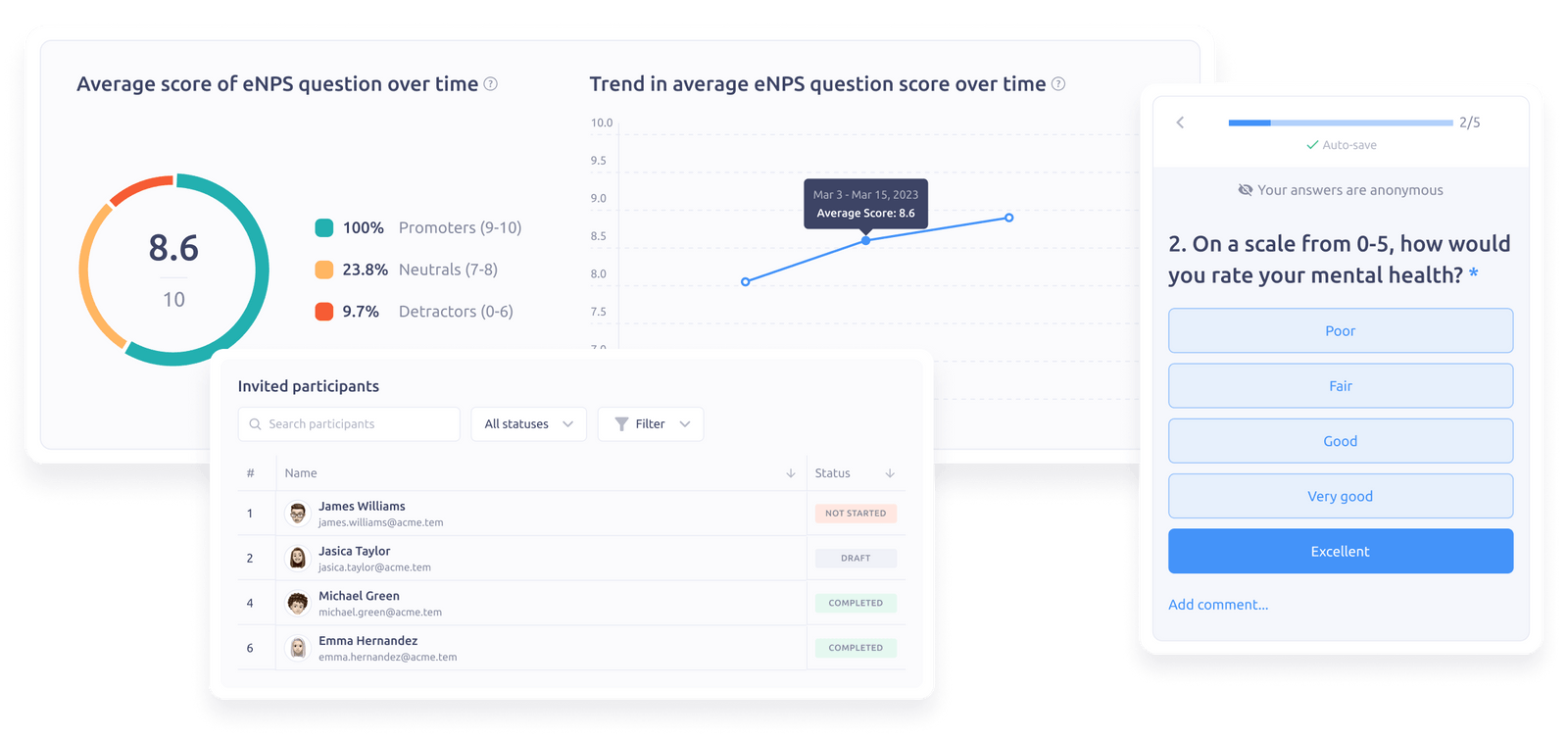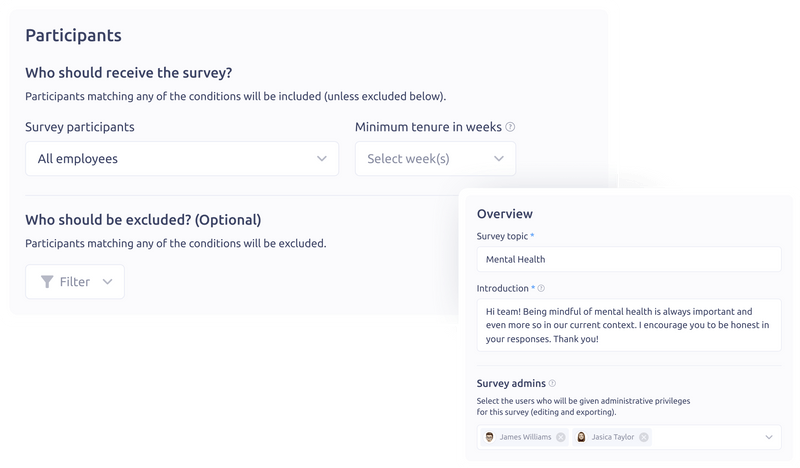
Are you an SMB owner struggling to conduct effective employee satisfaction surveys? Do you find yourself facing challenges such as limited resources, lack of expertise, or generic questions that fail to yield meaningful results?
Based on my experience as an HR expert, I can stress that investing time in designing and conducting employee satisfaction surveys may seem like a significant commitment. However, the long-term benefits for your company will far outweigh the effort. It is crucial for management to prioritize evaluating employee satisfaction, as it can significantly help to grow employee contentment as well as achieve business success.
In this article, we will provide you with 50 compelling questions for your first employee satisfaction survey, along with actionable tips to successfully conduct your questionnaire.

Employee satisfaction surveys play a vital role in understanding the needs and concerns of your workforce. They provide insights into how your employees feel about engagement, job satisfaction, and areas for improvement within your organization that may help reduce employee turnover.
From my experience, there generally isn’t much talk about employee expectations, management, feelings, or leadership in daily life of company. This is understandable as there isn’t that much room to get this kind of feedback on a daily basis.
But even when there is room, only 25% of managers actually tend to address these topics. “This is the reason why an employee survey should be in the company’s calendar.”
When creating pool of satisfaction survey questions, you should first consider their long-term relevance. “When creating categories and questions,” as our HR expert advises, “we should ask ourselves if these questions will be useful also in 2 - 3 years.”
Consider the approach recommended by the prominent HR research agency, AON Hewitt. The agency emphasizes the importance of well-defined categories and carefully crafted questions that cover various aspects of measuring employee satisfaction, engagement, and work experience.
When it comes to the question types, it is recommended to use a combination of closed-ended and open-ended questions. Closed-ended questions, which offer predefined response options, allow for quantifiable data analysis. Open-ended questions provide employees with the opportunity to express their thoughts and provide detailed feedback.
In terms of quantity, a well-balanced survey typically consists of approximately 40 closed-ended questions and 4-5 open-ended questions. This quantity strikes a balance between gathering sufficient data and not overwhelming participants with an excessively long questionnaire.
To encourage honest and unbiased responses, it is essential to maintain anonymity in the survey. Employees should feel comfortable expressing their opinions without fear of repercussions.
And, to minimize bias, consider the following:

The process of sending employee satisfaction surveys can be made much easier with the use of performance management software. Plai offers the feature of scheduling and updating recurring surveys effortlessly, making it easy to gather feedback at regular intervals.
The software automatically manages participant roles, adjusts questions over time, and ensures new team members are included in the survey process seamlessly.
Managers play a crucial role in utilizing the results of satisfaction surveys to drive positive change within the organization. Plai also empowers managers by offering tailored reports that can be shared with executives and other stakeholders.
Setting a reasonable timeframe when conducting employee satisfaction surveys involves defining the duration of the survey, communicating the timeline to employees, allowing sufficient response time, and considering the frequency of surveys.
Striking a balance between promptness and quality ensures employees have enough time to provide thoughtful responses.

There are two primary approaches to analyze the survey results: manual analysis or by utilizing analytics tools.
Manual analysis involves reviewing the survey responses individually, categorizing and organizing the data, and identifying patterns. While this method allows for a thorough examination of the data, it can be time-consuming and labor-intensive, especially for larger organizations with a substantial employee base.
Alternatively, using analytics tools like Plai streamlines the analysis process. Plai’s analytics feature offers robust capabilities to automatically process survey data. The software generates comprehensive reports and visualizations, enabling you to quickly identify key insights, trends, and areas for improvement.

Sharing the results of employee satisfaction surveys and implementing action plans based on the feedback received ensures that the survey is not just a data-gathering exercise, but a catalyst for positive change.
The company should have a lot of energy for the execution phase. If they just want to gather feedback and data, the participation rate will be lower next time. This emphasizes the importance of actively engaging with the survey results and taking tangible actions to address the concerns raised by employees. Merely collecting feedback without follow-through can lead to decreased participation and skepticism in future surveys.
It is essential to react to the survey findings and not simply view them as a static snapshot of employee sentiment. “React, don’t just ask, that’s not enough.” In another words “no survey plan without follow up plan (analysis, action plan, execution)”.
To ensure the successful implementation of action plans:
A performance management software can significantly aid SMBs in addressing the problems associated with employee satisfaction surveys in terms of:
With Plai, you have the convenience of effortlessly scheduling and updating recurring surveys. The software automatically handles tasks like adding new participants, making question adjustments over time, and adapting participant roles based on your team’s setup.

Plai also helps managers and executives by sharing customized reports and exporting data for further analysis and collaborative decision-making, ensuring the right actions are taken based on the insights gained.
You can also leverage Plai’s AI capabilities to quickly analyze reports, gain insights about your organization and team, and enhance your processes with intelligent suggestions, improving efficiency and effectiveness.

Here are some key takeaways from our conversation with our HR expert.





Through the collective efforts of HR professionals, managers, and organizational leaders, employee satisfaction surveys become more than just data collection exercises. They become catalysts for positive change and growth.
If you sign up for Plai, the tool can significantly streamline the survey process, enabling scheduled surveys, automated data analysis, and easy result interpretation.
By following HR experts’ advice and combining it with a tool like Plai, you will easily gain valuable insights into your workforce.
In this guide, you will find:
- OKR principles
- Formulas & scores
- OKR methodology
- Step-by-step guide
- Free OKR templates
- Common mistakes
Unlimited freemium for 14 days. Easy set up. No credit card required. 99% in customer satisfaction from G2 users.




Explore our comprehensive guide on the top 8 performance management software and find the tools offering the best route toward higher employee productivity.